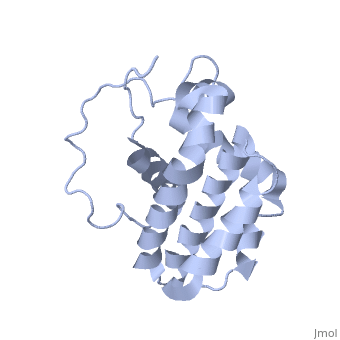1g5m
From Proteopedia
HUMAN BCL-2, ISOFORM 1
Structural highlights
DiseaseBCL2_HUMAN Note=A chromosomal aberration involving BCL2 has been found in chronic lymphatic leukemia. Translocation t(14;18)(q32;q21) with immunoglobulin gene regions. BCL2 mutations found in non-Hodgkin lymphomas carrying the chromosomal translocation could be attributed to the Ig somatic hypermutation mechanism resulting in nucleotide transitions. FunctionBCL2_HUMAN Suppresses apoptosis in a variety of cell systems including factor-dependent lymphohematopoietic and neural cells. Regulates cell death by controlling the mitochondrial membrane permeability. Appears to function in a feedback loop system with caspases. Inhibits caspase activity either by preventing the release of cytochrome c from the mitochondria and/or by binding to the apoptosis-activating factor (APAF-1).[1] Evolutionary ConservationCheck, as determined by ConSurfDB. You may read the explanation of the method and the full data available from ConSurf. Publication Abstract from PubMedThe structures of two isoforms of Bcl-2 that differ by two amino acids have been determined by NMR spectroscopy. Because wild-type Bcl-2 behaved poorly in solution, the structures were determined by using Bcl-2/Bcl-x(L) chimeras in which part of the putative unstructured loop of Bcl-2 was replaced with a shortened loop from Bcl-x(L). These chimeric proteins have a low pI compared with the wild-type protein and are soluble. The structures of the two Bcl-2 isoforms consist of 6 alpha-helices with a hydrophobic groove on the surface similar to that observed for the homologous protein, Bcl-x(L). Comparison of the Bcl-2 structures to that of Bcl-x(L) shows that although the overall fold is the same, there are differences in the structural topology and electrostatic potential of the binding groove. Although the structures of the two isoforms of Bcl-2 are virtually identical, differences were observed in the ability of the proteins to bind to a 25-residue peptide from the proapoptotic Bad protein and a 16-residue peptide from the proapoptotic Bak protein. These results suggest that there are subtle differences in the hydrophobic binding groove in Bcl-2 that may translate into differences in antiapoptotic activity for the two isoforms. Solution structure of the antiapoptotic protein bcl-2.,Petros AM, Medek A, Nettesheim DG, Kim DH, Yoon HS, Swift K, Matayoshi ED, Oltersdorf T, Fesik SW Proc Natl Acad Sci U S A. 2001 Mar 13;98(6):3012-7. Epub 2001 Feb 27. PMID:11248023[2] From MEDLINE®/PubMed®, a database of the U.S. National Library of Medicine. See AlsoReferences
| ||||||||||||||||||
Categories: Homo sapiens | Large Structures | Fesik SW | Kim DH | Matayoshi ED | Medek A | Nettesheim DG | Oltersdorf T | Petros AM | Swift K | Yoon HS


